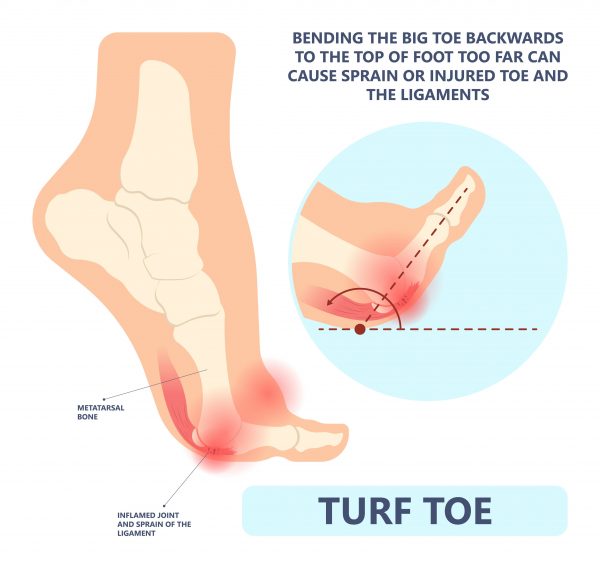Turf toe may have gotten its name from the big toe injury football players can get when playing on artificial grass (turf!), but just about anyone can get it.
Below, we’ll discuss turf toe, how it can impact your feet, turf toe treatment options, and more to help you get off the tough turf and back on the path to happy feet.
What Is Turf Toe?
Turf toe is a sprain of the big toe joint caused by hyper-extension. This can happen during activities that cause significant stress on the forefoot, such as during sudden starts and stops or switching directions when playing sports. While it’s true that you’ll commonly see football players with turf toe, it can also happen in many other sports including basketball, soccer, martial arts, and dance.

You Can’t Walk Away To Avoid It
Even if sports aren’t your thing, you can still get turf toe from old-fashioned walking— especially if you’re wearing the wrong shoes. Since it’s a sprain, there’s a risk any time you bend your big toe past its normal range of motion.
Turf Toe Symptoms
Symptoms are similar to other sprains and typically include:
- Pain
- Swelling and bruising at the base of the big toe
- Limited range of motion
The Anatomy and the Grades
Based on severity, turf toe is divided into grades. The plantar complex is made of thick, fibrous tissue (plantar plate) that supports the big toe joint as well as ligaments and tendons that help the big toe move and flex. The higher the grade, the more damage there is to the plantar complex.
Grade 1: Slight sprain. In a Grade 1 injury, parts of the plantar complex have been strained, resulting in mild swelling and tenderness.
Grade 2: It hurts. In a Grade 2 injury, there may be some tearing of the ligaments or tendons within the plantar complex. You’ll likely have more pain and swelling and a limited range of motion in your big toe.
Grade 3: Sit down and call your podiatrist. You’ll be feeling this one, the plantar complex will have a full tear— or multiple tears— and you may not be able to move your big toe at all (and if you do, you’ll probably regret it).
Turf Toe vs. Gout
Gout is similar to turf toe, but there is a major difference in how these injuries occur. Gout is joint damage from internal causes while turf toe is due to an external force. However, a turf toe injury could trigger a gout attack if you already have a high risk of developing gout.
Turf Toe Treatment Options
Depending on the severity of turf toe, you have a few options for a speedy recovery.
For mild (Grade 1) big toe sprains, you can try the RICE method:
Rest your big toe by staying off of it as much as possible.
Ice your big toe to reduce swelling.
Compress your big toe by wrapping your foot with a bandage (but not too tight!).
Elevate your foot with a pillow or other soft items to keep your foot above your heart.
If you show signs of a Grade 2 or 3, it may be best to seek turf toe treatment from your podiatrist. They can offer medication to reduce pain and swelling, a boot or cast to aid healing, and surgery as a last resort.
Can You Prevent Turf Toe?
The good news is that yes, you can prevent turf toe! Aside from stretching your feet and ankles before activities and sports, look for shoes that are hard-soled and offer toe and joint support. You can also practice proper running mechanics and ensure that your gait is within a normal range.
Exercises that strengthen your feet can also help reduce your risk of turf toe. And of course, if your feet feel tired, remember to take breaks and drink plenty of water.
Treat Your Feet: Professional Turf Toe Treatments at The Foot & Ankle Group
If you are experiencing serious turf toe or your symptoms refuse to go away, it’s time to come in and let us take care of you. With our multiple SW Florida podiatrist locations, we try our best to fit in serious injuries with same-day appointments.
Schedule an appointment with The Foot & Ankle Group today.
Categorized in: Blog
Comments are closed